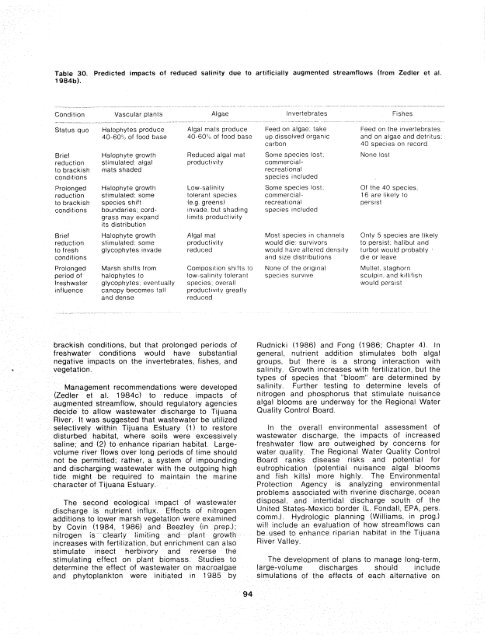The Ecology of Tijuana Estuary, California: An Estuarine Profile
The Ecology of Tijuana Estuary, California: An Estuarine Profile
The Ecology of Tijuana Estuary, California: An Estuarine Profile
Create successful ePaper yourself
Turn your PDF publications into a flip-book with our unique Google optimized e-Paper software.
Table 30. Predicted impacts <strong>of</strong> reduced salinity due to artificially augmented streamflows (from Zedler et al.<br />
1984b3.<br />
Condition Vascular plants Algae Invertebrates F~shes<br />
Status quo Halophytes produce Algal mats produce Feed on algae take Feed on the ~nvertebrates<br />
40-60" <strong>of</strong> food base 40-6OoC, <strong>of</strong> food base up d~ssolved organlc and on algae and detr~tus<br />
carbon<br />
40 species on record<br />
Br~ef Halophyte growth Reduced algal mat Some species lost None lost<br />
reduct~on stimulated algal product~v~ty commercialto<br />
brackish mats shaded recreat~onal<br />
cond~tions<br />
specles ~ncluded<br />
Prolonged Halophyte growth Low-salin~ty Some species lost Of the 40 specles<br />
reduction stimulated, some tolerant spec~es commerc~al- 16 are likely to<br />
to brackish species shift (e g greens) recreational pers~st<br />
condit~ons boundaries, cord- Invade but shad~ng species included<br />
grass may expand lrmits product~v~ty<br />
~ts distribut~on<br />
Brief Halophyte growth Algal mat<br />
reduct~on sttmulated. some productiv~ty<br />
to fresh glycophytes invade reduced<br />
conditions<br />
Most species in channels<br />
would die: survivors<br />
would have altered density<br />
and size distributions<br />
Only 5 species are likely<br />
to persist, halibut and<br />
turbot would probably<br />
die or leave<br />
Prolonged Marsh shlfts from Composltlon sh~fts to None <strong>of</strong> the or~g~nal Mullet staghorn<br />
per~od <strong>of</strong> halophytes to low saliri~ty tolerant species survive sculpin and k~ll~fish<br />
freshwater glycophytes eventually spcc~cs overall would pers~st<br />
influence canopy becomes tall productiv~ty greatly<br />
and dense<br />
redoced<br />
brackish conditions, but that prolonged per~ods <strong>of</strong> Rudnlcki (1986) and Fong (1986; Chapter 4) In<br />
freshwater cond~tions would have substantla1 general, nutrient addition st~mulates both algal<br />
negative impacts on the invertebrates, fishes, and groups, but there is a strong ~nteract~on with<br />
vegetation<br />
sal~n~ty Growth increases wlth fert~lizat~on, but the<br />
types <strong>of</strong> species that "bloom" are determ~ned by<br />
Management recommendat~ons were developed sallnlty Further testing to determ~ne levels <strong>of</strong><br />
(Zedler et al. 1984~) to reduce Impacts <strong>of</strong> nitrogen and phosphorus that st~muiate nuisance<br />
augmented streamflow, should regulatory agencies algal blooms are underway for the Regional Water<br />
decide to allow wastewater discharge to T~juana Quality Control Board<br />
R~ver. It was suggested that wastewater be utlllzed<br />
selectively with~n <strong>Tijuana</strong> <strong>Estuary</strong> (1 to restore In the overall environmental assessment <strong>of</strong><br />
disturbed habltat, where soils were excessively wastewater d~scharge, the Impacts <strong>of</strong> Increased<br />
saline, and (2) to enhance rlparian habttat Large- freshwater flow are outwe~ghed by concerns for<br />
volume river flows over long per~ods <strong>of</strong> time should water quality <strong>The</strong> Reg~onal Water Quality Control<br />
not be permitted, rather, a system <strong>of</strong> ~mpounding Board ranks disease risks and potentlal for<br />
and dlscharglng wastewater w~th the outgoing high eutrophicatron (potential nulsance algal blooms<br />
tide might be requ~red to maintain the marlne and flsh kills) more hlghly <strong>The</strong> Environmental<br />
character <strong>of</strong> <strong>Tijuana</strong> <strong>Estuary</strong> Protectron Agency 1s analyzing environmental<br />
problems assoctated wlth rlverine dlscharge, ocean<br />
<strong>The</strong> second ecologtcal impact <strong>of</strong> wastewater disposal, and intertidal dlscharge south <strong>of</strong> the<br />
dlscharge is nutr~ent influx. Effects <strong>of</strong> nitrogen United States-Mexlco border (L Fondail, EPA1 pers<br />
additions to lower marsh vegetation were examtned comm ) H~drologic ~lannlng (Williams. In prog.)<br />
by Covin (1984, 1986) and Beezley (in prep 1, will include an evaluation <strong>of</strong> how streamflows can<br />
nttrogen is ciearly iimr[ing and pfafit growth be used to enhance rlparlan habitat the T~~uana<br />
increases wrth fertiilzatlon, but enrichment can also River Valley<br />
stimuiate insect herbivory and reverse the<br />
strmulating effect on plant biomass Studies to <strong>The</strong> development <strong>of</strong> plans to manage long-term,<br />
determine the effect <strong>of</strong> wastewater on macroalgae large-volume discharges should include<br />
and phytoplankton were initiated in 1985 by simuiat~ons <strong>of</strong> the effects <strong>of</strong> each alternative on<br />
94

















